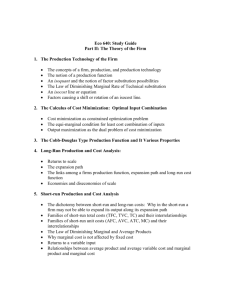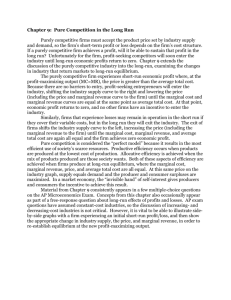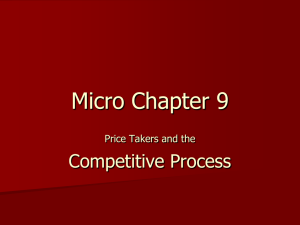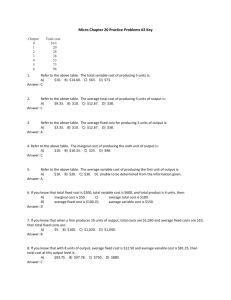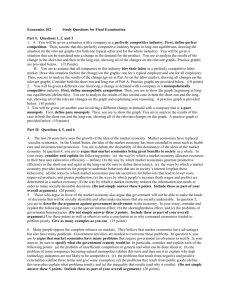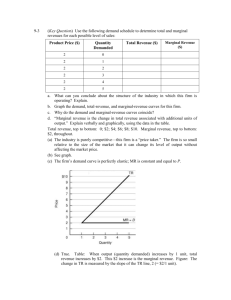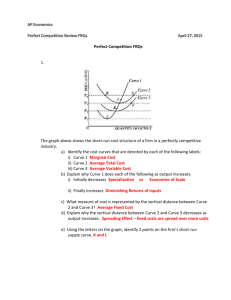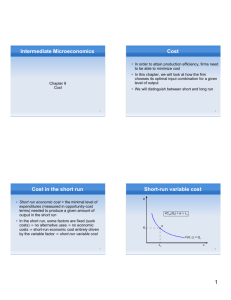Intermediate Microeconomics Price-taking firm Two rules for profit
advertisement
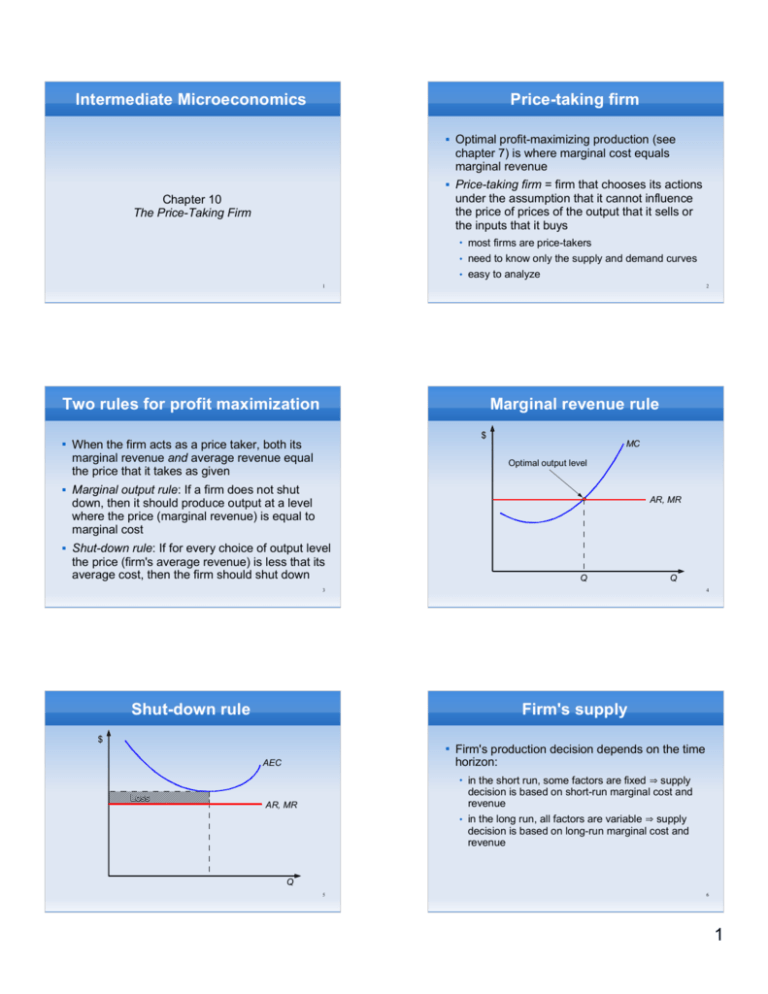
Intermediate Microeconomics Price-taking firm Optimal profit-maximizing production (see chapter 7) is where marginal cost equals marginal revenue Price-taking firm = firm that chooses its actions under the assumption that it cannot influence the price of prices of the output that it sells or the inputs that it buys Chapter 10 The Price-Taking Firm most firms are price-takers need to know only the supply and demand curves easy to analyze 1 2 Two rules for profit maximization Marginal revenue rule $ When the firm acts as a price taker, both its marginal revenue and average revenue equal the price that it takes as given MC Optimal output level Marginal output rule: If a firm does not shut down, then it should produce output at a level where the price (marginal revenue) is equal to marginal cost AR, MR Shut-down rule: If for every choice of output level the price (firm's average revenue) is less that its average cost, then the firm should shut down Q Q 3 4 Shut-down rule Firm's supply $ AEC Firm's production decision depends on the time horizon: Loss AR, MR in the short run, some factors are fixed supply decision is based on short-run marginal cost and revenue in the long run, all factors are variable supply decision is based on long-run marginal cost and revenue Q 5 6 1 Production decision if price > p* Production decision if price < p* $ $ Profit MCSR MCSR AVCSR p1 AVCSR Loss p* p* p2 Q* Q1 Q2 Q* Q Q 7 Short-run supply curve Short-run supply curve At any price above p*, the optimal output level is given by the marginal revenue rule: produce at the level at which MC = MR, hence MC = price At any price below p*, the shut-down rule becomes binding and thus the optimal output level is zero (firm out of business) Finally, the short-run supply curve consists of two parts: vertical line at zero, for any price below p* the part of the MCSR curve above p* p* The difference is that now we use the long-run marginal and average cost The long-run supply curve consists, again, of two parts: the part of the MCLR curve above p* 10 Long-run supply curve We can use the same logic to derive the long-run supply curve vertical line at zero, for any price below p* Q Q* 9 P SSR Long-run supply curve 8 P SLR p* Q* 11 Q 12 2 Long-run vs short-run supply curve Factor demand P SSR Derived demand = a firm's demand for an input is known as derived demand because it depends on (is derived from) the demand for the firms output Again, we need to consider the short run and the long run separately The same logic as before can be applied to factor markets SLR Q* Q 13 14 Short-run factor hiring rule Are the rules consistent? The firm should hire an input just up to the amount at which the marginal benefit to the firm is equal to the marginal cost Marginal revenue product (MRP) = change in revenue due to the sale of the additional output contributed by the hiring one more unit of a factor MRPf = MPPf × MRf = MPPf × p Short-run production rule: MC = p But: remember that MC = MFC / MPP (chapter 9) MFC = MPP × p Short-run factor hiring rule: MRP = MFC But: MRP = MPP × p MFC = MPP × p Marginal factor cost (MFC) = price of input (w) Rule: hire factor until MRPf = MFCf 15 Short-run factor demand A firm that is a price-taker in both the factor market and the output market maximizes its profit by hiring a factor up to the point at which MPP × p = w Then, the short-run derived (factor) demand curve for a firm that is a price taker in the market for the variable input coincides with the firm's marginal revenue product curve for that factor Downward slope because of the output effect: a higher input price leads to lower output and 17 hence less of the input being demanded Hence, both laws actually give the same relationship, just in different forms 16 Short-run derived demand curve (labor) w DL,SR Q 18 3 Long-run factor demand Substitution effect of wage increase Capital In the long run, all factors are variable In this case, an increase in the price of a factor has both an output effect (similar to the income effect) and a factor substitution effect 2 1 Factor substitution effect = reduction in the quantity demanded of an input that results from the firm's substituting away from a factor when it's price rises Isoquant Initial isocost line The factor substitution effect is always negative, but the output effect can be positive or negative 19 (compare to chapter 4!) Effects of wage increase 20 Long-run factor hiring rule Capital The short-run factor hiring rule has to hold for all factors now (since they are all variable) In particular: Initial isoquant 2 3 Labor substitution effect MPPL × p = w 1 MPPK × p = r Final isoquant Final isocost line Initial isocost line OE SE This leads to the same condition that we had for cost minimization! MPP L Labor MPP K 21 = w r 22 4

